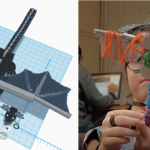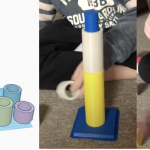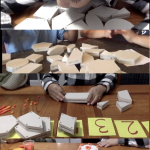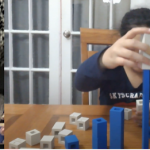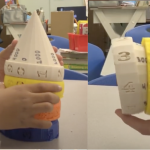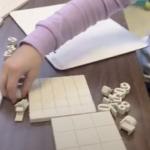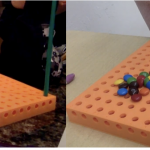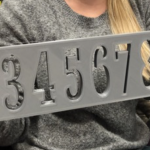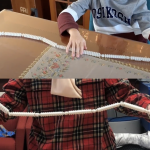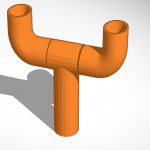Month: September 2020
Fraction Rings
Click here to download the stl file for this tool. [TBP]
My math manipulative is a variety of rings which each represent different fractions (from 1/2 to 1/8) that are scaled in relation to the pedestal that they go on top of. The relation between fractions with different denominators can be confusing. This manipulative helps students realize that several fractions with different denominators can be composed to make up the whole. This manipulative helps students make sense of fractions with different denominators and the relations between them.
Geometric TouchPoints
Click here to download the stl file for this tool. [TBP]
Our manipulative began as an idea stemming from what we learned about our students’ mathematics, which we learned about in our interview with them. We wanted them to learn more about numbers, so we thought it would be a great idea to apply touchpoints to geometric figures. The geometric figures we designed are a square, oval, circle, rhombus, diamond, trapezoid, pentagon, hexagon, an isosceles triangle, equilateral triangle, and a house. We wanted to use them to give students a reason to count. We would ask them to count the sides and the vertices, and maybe see if they could find a relationship between the two numbers.
3D Vertical Fraction Strips
Click here to download the stl file for this tool. [TBP]
The manipulative I made is a 3D version of fraction strips. Each strip is a rectangular/square piece that slides onto individual pegs, making them both sturdy and easy to play with. I’ve also made it so that the fraction blocks stack vertically (rather than lining up horizontally), to indicate height as value and amount. I wanted to build something to help the student to visualize and deepen their understanding as they explored fraction relationships. What was most important to me was having all the fractions mounted on one platform with the 1 (whole) always being visible, so that the student could begin to grasp how all the smaller parts relate to the whole.
Place Value Cones
Click here to download the stl file for this tool. [TBP]
For my manipulative I have taken something that I have seen being used within classrooms. Many people call them place value cups. Mine are place value cones. The reason I changed it into cones was because my student enjoys art, so I wanted them to look like crayons. I felt that this would interest my student a lot. Besides the look of it, I feel that my manipulative can serve multiple topics and have different purposes. My one hope is that it helps my student learn place value concepts so that they can perform addition and subtraction more meaningfully.
The Area Blocks
Click here to download the stl file for this tool. [TBP]
“Research suggests that it is a significant leap for students to move from counting squares inside of a rectangle to the conceptual development of a formula.” I created a tool named “The Area Blocks.” These manipulatives are quadrilaterals with different measures. I believe this manipulative will support the students’ learning because the children will see, touch, and count to find the area of a quadrilateral. They can also compare and contrast areas that have the same numbers of unit squares but have a different measure.
3D Multiplication Table
Click here to download the stl file for this tool. [TBP]
The manipulative is a three dimensional multiplication table embedded with tubes so that poles can be inserted at either end, or both ends simultaneously. In using the manipulative, students are provided with a visual representation of multiplicative relationships. The purpose of our manipulative is to support understanding of the mathematics of multiplication and division problems. They will be able to relate the multiples of numbers for multiplication and the factors for division, discover a concept of repeated addition and subtraction, and discover other patterns of their own.
Number Line and Slider
Click here to download the stl file for this tool. [TBP]
My manipulative is a number line including the numbers 1-10. It has a sliding piece that goes on top of it that students can use when adding, subtracting, or even finding the number before or after a given number. When the slider is moved over the number line, it highlights just one number by placing the number in the center of the sliding box.
Decimal Snake
Click here to download the stl file for this tool. [TBP]
I learned from an interview with a 5th grader that he was struggling with ordering decimals. Ordering decimals requires an understanding of place value. I started thinking about a tool that can help him build a conceptual understanding of how decimal numbers are constructed. During our informal interview, I realized that he likes snakes. So, I decided to create a tool that is interesting to him and will attract his attention and have a mathematical meaning to it. So, I decided to design a decimal snake. The decimal snake consists of 10 pieces. In each piece there will be 10 small increments representing a unit. Having 100 units on the snake will help us to represent decimals in tenths and hundredths place. I created the decimal snake in the hopes that it helps him visualize the meaning of each decimal.
Y Arithmetic
Click here to download the stl file for this tool. [TBP]
I designed this tool because my four-year-old student loves shapes, and shapes and patterns are both important and appropriate topics for preschoolers. My manipulatives consist of three large, three-dimensional shapes (triangle, square, and hexagon) each with a “hole” placed throughout the middle of the entire manipulative. In addition, I have 6 thinner manipulatives (3 triangles, 3 squares, and 3 hexagons) each of a different size, yet only one of each shape will fit perfectly through the middle of the larger manipulative of the same shape. I want my student to explore the polyhedra and see the patterns he comes up with.
Shapes for Exploration
Click here to download the stl file for this tool. [TBP]
I am designing this tool because my four-year-old student loves shapes, and shapes and patterns are both important and appropriate topics for preschoolers. My manipulatives consist of three large, three-dimensional shapes (triangle, square, and hexagon) each with a “hole” placed throughout the middle of the entire manipulative. In addition, I have 6 thinner manipulatives (3 triangles, 3 squares, and 3 hexagons) each of a different size, yet only one of each shape will fit perfectly through the middle of the larger manipulative of the same shape. I want my student to explore the polyhedra and see the patterns he comes up with.

